Financial incentive and genetic improvement programs along with stable grain prices are paving the pathway for Mexico’s herd recovering, however, the herd recovery in the U.S. would slow live cattle exports in the short/medium term. As Mexico’s production is expected to grow during 2017, increased beef exports will maintain stable per capita beef consumption. While Mexico learns how to deal with porcine epidemic diarrhea (PED) and to make genetic improvements in domestic herd, pork production is expected to bolster supplies, increase price competitiveness with other meats, and therefore, increase consumption. The recently-created Animal Protein National Commission (CONAPO) would advocate for increased protein consumption regardless the animal origin. During 2017, Mexico will continue importing beef and pork from the United States.
Stable grain prices would boost production in the mid-term
Mexico’s main financial incentive program, which continues enticing producers to repopulate the domestic herd, is reportedly meeting its objectives. Mexican cattle production is forecast to expand to 7.1 million head in 2017, as producers who are registered for the 2016 Program to Promote the Livestock Sector (“Programa de Fomento Ganadero”) are reportedly entitled to continue receiving a direct subsidy for 2017. Improved genetics through the Program for Genetic Improvement are expected to aid cattleman in the recovery of the domestic herd as well.
As previously reported, this program is enabling producers to remain in business and to offset obstacles to repopulation that the domestic herd has previously encountered, in particular, the lack of steers for feedlots. Due to the incentive to feed steers, calf slaughter is expected to decline by the end of 2016, but will likely rebound in 2017. Despite an ample supply of grain and pasture in 2016, herd expansion is unlikely to occur until 2017 at the earliest.
Read more 

